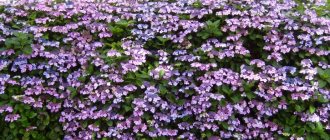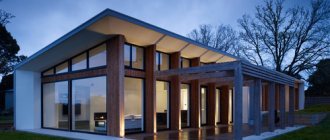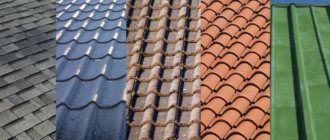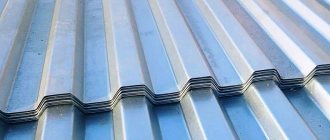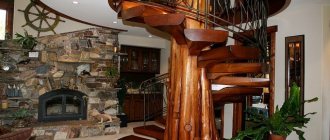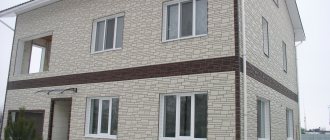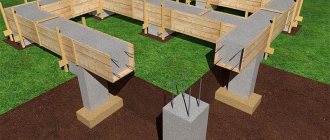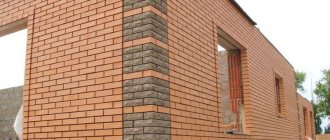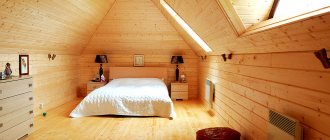Fence options for private homes and cottages
They are divided into several models:
- Fencing as a means of protection against the entry of animals or people into the territory of the dacha. With their help you can also hide from prying eyes.
- A decorative fence performs only aesthetic functions; it is shown to guests as decoration.
- The base for a living fence can be either a wooden or metal frame.
- A fence from noise and dust from the street - it can be made either transparent or translucent. In this case, daytime sunlight will penetrate into the suburban area, which is important if fruit trees are grown at the dacha. At the same time, the fence will protect the house from noise, dust and strong wind.
- A fence to mark the boundaries of a land plot - it must be installed so that there are no disputes when dividing the plot with the closest neighbors.
The fence must be in harmony with the objects of the site
There are several types of design:
- Stationary - they are installed using support pillars. Fences can be made using various materials.
- Monolithic - most often they are concrete, brick or stone.
- Collapsible - these are structures made of chain-link mesh; it is possible to disassemble them and move them to a new location.
- Portable - fences, like previous structures, can be moved from place to place. They are built from polycarbonate or plastic.
Stone fence
Stages of construction
How to build a fence with your own hands? So, the construction of the fence takes place in several stages:
Planning and marking. Before starting work, it is necessary to draw up a drawing of the fence indicating its dimensions and the location of the gate and wicket. Then we transfer the drawing to the construction site.
Read here - Beautiful fences: modern fencing models and recommendations for choosing a design (140 photos)
The boundaries of the future fence must be marked with pegs and twine stretched between them. Additionally, using pegs, you need to mark the location of the support pillars. The distance between them should be from 2 to 3 meters.
Foundation. If you are building a stone or brick fence, then keep in mind that such a massive structure requires a solid foundation. The approximate depth of the trench for the foundation is 70 centimeters and the width is 40.
Installation of support pillars. Laying fence spans.
After learning more about the stages of fence construction, you will know exactly how to make a fence correctly.
Materials for making fences
When looking for an answer to the question of which fence is best to install, you need to pay attention to the material of its production.
WPC option
Concrete
Concrete fences consist of individual blocks and support pillars. They have a long service life. It is also possible to build them in a short period of time. A concrete fence can be erected on any soil. But such construction will be quite expensive. To install it you will have to hire construction equipment. It is imperative to follow the technology when constructing a fence, otherwise it will warp after the first winter. An example of it is shown in the photo.
Device made of concrete sections
Metal
Metal fencing is very popular. If you choose this type of fence, there will be no difficulties with its installation, and the materials can be purchased at affordable prices. It will completely cover the area from the prying eyes of neighbors. The fence will last for a long time. The material most often used to create a gate is corrugated sheet.
It is possible to choose one or another color of the metal profile.
Option from profiled sheet
If you use galvanized corrugated sheets for garden fences, it will be protected from moisture and temperature changes. The material weighs very little. It will not fade in the sun. However, sunlight will not penetrate the proper area, which will adversely affect the growth of fruit trees. Such a metal fence has another significant drawback - its unaesthetic appearance.
Forged structures are “imbued” with wealth and luxury
A wrought iron fence will be very attractive. It is possible to make such fences unique, since they are manufactured according to individual drawings. The dacha area will be ventilated and the sun's rays will begin to penetrate it.
However, over time, corrosion may appear on the metal, so it must be pre-treated with special compounds. Also, a wrought iron fence will not hide you from prying eyes.
Metal mesh and stone
Tree
A wooden fence is environmentally friendly and safe. She has an attractive appearance. The fence is erected in a short period of time. It will fit perfectly into any landscape design. The materials weigh a little, so there will be no difficulties with their delivery. But this option has a short service life. A sample can be seen in the photo.
These products require regular maintenance
Brick
The brick model is a durable and good option. It will harmonize perfectly with both stone and metal support pillars. It will last for more than a century. You don't need to take care of it.
However, you will have to pour a monolithic foundation for it, and this will be expensive. Fence laying must be done by specialists. The disadvantage of such a fence is that the area will not be ventilated.
This variety is a reliable and durable protection for the site.
Stone
Options for a stone fence are quite common. It has a presentable appearance and will last for a long time. It differs from other types in its high strength. They don't require any care. But there is a minus - its arrangement will be quite expensive.
Stone fence
Rabitz
If you install a chain link, then the entire dacha will be clearly visible. Such a fence can be installed at an affordable price. Installation will not take much time. The design is lightweight. But with its help you will not be able to hide from your neighbors, and there will also be no protection from noise, wind and dust.
The use of this material is relevant for fencing small summer cottages
Plastic
This type of fencing has an aesthetic appearance; it can be used to divide a summer cottage into several functional zones. The material will withstand temperature changes and exposure to high humidity.
Plastic specimens are less susceptible to the harmful effects of moisture
The advantage of the fence is that even after a long period of use it will not fade in the sun. It is possible to choose any design. But this option is not resistant to mechanical stress and strong wind. It has a short service life - only 10-15 years. A sample is in the photo above.
Types of fences and enclosures
Wooden fences
The advantage of all fencing structures made of wood is their affordable cost; if you have a limited budget, then you can even mount both a temporary and permanent fence from wood yourself. Wood is a material that is easy to use and convenient to install a fencing structure. In any location, having its own unique pattern, any lumber will give the site a well-groomed and beautiful appearance, and if it is treated with special coloring compounds, the aesthetics of the fence will be transformed threefold.
Wooden fences also have a sufficient number of disadvantages, the most important of which is the comparative fragility of the material, due to its sensitivity to seasonal changes in humidity and temperature. Under the influence of the environment, wood rots, darkens, can change its shape and geometry, in addition, insects and rodents show interest in it, and it is not resistant to fire. The occurrence of the listed threats is minimized by treating wooden fence elements with special protective impregnations, varnishes, and paints, but does not create one hundred percent protection against such manifestations . It is significantly inferior in strength to alternative concrete and metal materials, so if your site is located in close proximity to a busy and winding roadway, then installing a wooden fence is not the best solution. Thus, wooden fencing requires frequent attention and maintenance, which is why it is well suited for households with permanent residence of the owners or as a temporary barrier during construction work.
wooden fence
With all of the above, wooden fences are in great demand and have many varieties depending on the installation method, design, type of wood and lumber used.
Metal fences
This category of fencing also has many varieties and is more popular in comparison with its wooden counterparts, despite its lower availability in the price category. A wide variety of materials are used for metal fencing structures and these include:
- Corrugated sheets - steel sheets of different thicknesses.
- Chain-link mesh and welded mesh - made of metal, galvanized, with different diagonals and cell shapes.
- Forged metal fences are the most expensive variation of metal fences, which are made both by stamping and by artistic forging from hollow metal rods, pipes, corners and other rolled metal, which are held together into a single structure by rune welding.
- Cast metal fences - cast from cast iron into a single monolithic section in a specific pattern, are characterized by particularly high durability.
- Metal picket fence
corrugated fence
Metal fences are characterized by a high level of wear resistance and durability; forged fences last for centuries. The high strength of the metal creates reliable protection for the site, protecting its contents from external influences. Metal products can be given any shape and satisfy almost any aesthetic needs.
chain link fence
At the same time, metal fencing has a number of significant disadvantages, the main ones include: the high cost of most metal structures and installation work, with the exception of corrugated steel sheeting. Prone to corrosion and rust, which requires periodic surface treatment and coating with protective mixtures and mastics. The heavy weight of the metal structure, for which it is necessary to lay a stronger, more massive foundation. The complexity and high cost of repair work, which consists in the need to use manual welding if it is necessary to replace a separate element or completely change a section if it is a single structure in the form of a sheet or cast product.
example of a wrought iron fence
Stone fences
Another, larger variety of reliable and heavy fences. The category of stone fences includes fences made of brick, cinder block, wild and rubble stone, cast reinforced concrete fences, fences made of gabions and their combined variations.
The advantages of stone fences include high strength and strength. Fencing made of any stone creates a real barrier to home ownership. Reliably protects and is highly resistant to any mechanical damage. A stone fence is characterized by average durability; it lasts much longer than a wooden one and much less, unlike metal structures. Does not require constant care. For many years, without destruction, it can withstand temperature changes from negative to the hottest, and can withstand high humidity and dryness. Protects the territory from strong winds and is resistant to them, does not show windage.
brick fence
The main disadvantage of fences made of artificial or natural stone is its weight, which requires laying a massive foundation. The complexity of the work can also be considered a disadvantage, since it is possible to build stone walls around the perimeter of the entire household alone, but it is difficult and time-consuming. The cost of the fence depends on the chosen material and can be either affordable or extremely expensive if expensive masonry and facing materials are used. Requires external finishing, which must be periodically restored to maintain aesthetics.
stone fence
Fences made of roofing materials
A type of fencing that spontaneously arose in the construction world from materials not intended for direct use. This category includes fences made from building materials that were made for other purposes: for finishing roofs, building facades, walls and interior decoration. Serve both for temporary use and as an element of a permanent structure. Roofing polycarbonate, construction slate and slate panels, many types of siding, various types of DSP construction panels and others are very popular among such materials. Read more about the pros and cons of DSP panels.
wave slate fence
The advantages of the materials are: economical cost and a wide variety of types, which allows you to realize many design fantasies. The lightness of the materials does not require the construction of massive bases. Easy to install and quick to repair damaged parts.
polycarbonate fence
The disadvantages of such fencing include their fragility and poor resistance to mechanical stress, since the strength of finishing materials that are used for other purposes is not initially designed for the construction of fencing structures. Solid panels always create windage in strong, gusty winds, thereby loosening the base of the fence and increasing the risk of damage. The relatively low durability is due to the inability to withstand mechanical damage. Most of these materials are artificial, containing polyvinyl chloride and similar components, which does not have the best effect on the environmental friendliness of such a fence and increases the fire hazard.
siding fence
Hedges
The main function of living fences is decorative. With the help of densely growing shrubs and dwarf trees, a conditional fence is created, which creates a beautiful appearance on the territory and marks the perimeter of the site. This category of fencing, which is not capable of performing a protective function, is installed as part of a landscape design to internally delimit a space that already has a secure fence. Such plantings can be found in public parks, museum areas that are historical monuments, or as an element of the garden ensemble of private homeowners.
thuja hedge
Wooden fences
The types of wooden fences for private houses are very diverse and fit perfectly into the interior of courtyards.
Wooden fencing option
Ladder or Christmas tree
Herringbone - it is also called a ladder. From a distance, such a fence can be confused with metal siding. But up close it is possible to see small gaps between the picket fence.
With this layout, summer residents protect their private corner from dust from the street, while the area will be ventilated. The design can withstand even strong winds. It is possible to view samples of fences on the website.
Ventilated model
Classical
The classic type, a picket fence, can be positioned both vertically and horizontally. Its base is made of brick or stone foundation. You can also use support posts to mount the fence. But the fence should be painted to protect it from moisture.
Sample of a blind fence
Wattle
He has an attractive appearance. It was used to fence the territory back in ancient times. This is a traditional option among the Slavic people. It can also be used as decoration.
To protect the home from dust, wind and prying eyes, a high fence is erected and combined with other materials. An example of a barrier in the photo. The disadvantage of such a fence is that it will take a lot of time to install.
This type of fence is most often installed between areas
Ranch
Ranch style fencing is also quite popular. If you put it in your dacha, you can protect your garden from animals. But you can choose a beautiful type for your home area.
An example of a fence is shown in the photo below.
Structures of this type serve more of a decorative function than a protective one.
Lattice
Lattice - slats are attached to pre-installed pickets at an angle of 45 degrees. They intersect with each other. The design is airy; flows of air and sun will flow through it unhindered into the dacha area. The fence looks like a beautiful picture.
Lattice models
Palisade
The fabulous, but nevertheless real appearance of the hedge itself has been used in decoration for as long as the wattle fence. This type of fence is perfect for protecting your area from uninvited guests. It has a distinctive feature - pointed upper edges. To make the structure durable, a foundation or support pillars made of stone is used when installing it.
It also needs painting.
Logs must be installed at minimum distances from each other
Fence
The picket fence is the most popular type among summer residents. The height and width of the pickets are selected individually. They are attached to a wooden frame using self-tapping screws. If they are placed close to each other, the area will be protected from dust and prying eyes. This type is often chosen for installing a gate.
The photo below shows a wooden picket fence.
Such products have gained popularity due to their ease of assembly.
Chess
For its installation, different options for picket fences, palisades and standard fencing are used. A distinctive feature of the species is the front side on both sides. To hide the area from neighbors, wide boards are used when installing the fence.
The advantage of this type is the installation of a beautiful fence on the outside and inside
Brick fence design
And in the last section of the article we will talk about the design of brick fences for a private home!
In SNT, villages and dachas, brick is used relatively rarely: it is bulky and expensive, and if construction rules are not followed, it quickly collapses. However, in the private sector, such fences are still in demand - and you can also create something interesting with the help of brick and stone!
vertical garden
A vertical garden is not an easy solution to implement, but if everything works out, it will be 100% worth all the work. The combination of lifeless brick and bright living plants gives an extraordinary result.
The garden can be simplified by attaching wooden strips to the brick on which pots of climbing flowers are hung. Nature will do the rest itself.
Completely concreted
An old brick wall can be completely concreted, the main thing is to choose high-quality cement. And just a few perfectly smooth deep lines in a fresh solution will turn an ordinary gray surface into an installation.
Brick and forging
There is a duo that you can resort to if you don’t like anything at all: brick pillars with a foundation plus a wrought-iron metal fence. Simple, solid, tasteful, suitable for almost any country house, except for very rustic-pastoral chalets. You can choose any forging, from strict to playful - with curlicue leaves.
Clearances in solid masonry
A solid brick fence three meters high looks depressing, so designers lighten it by adding decorative gaps. Firstly, it creates an association with the loopholes of medieval castles, secondly, it lets sunlight into the courtyard, and thirdly, it looks nice.
The design of fences for a private house is not limited to these 14 examples, because it is not limited by anything except imagination and budget. Looking at the photographs, you may come up with some original idea - and build a strong, reliable and beautiful fence that will have no analogues.
Metal fences
Characterized by the following:
- this is a popular option among consumers for households;
- You can install it yourself; it is also used for gates.
The photo shows a fence made of metal and polycarbonate.
Metal structures are distinguished by their unique sophistication
From grids
The chain-link is a prefabricated structure accessible to all summer residents. With its help, they protect vegetable gardens and gardens from animals. The mesh is made of steel wire or stainless steel. The smaller the mesh, the higher the reliability indicators. This is an open type of hedge.
Moderate strength is complemented by the low cost of the material
Welded mesh - the fencing structure is divided into several sections. It is made from steel wire. First, metal pipes are installed. The wire is welded to them using welding. This type is used for fencing garden areas so that the fence allows the sun to pass through and the area is ventilated. But rodents can enter the dacha through the sections.
From the twigs
A twig fence has an attractive appearance. The structure will consist of several rods. They are attached to each other by welding. The construction of such a fence will not cost much.
Welded fence - pictured below.
Welded rod fencing
From corrugated sheets
The type of fence made from corrugated sheets is an economical option. Profiled steel sheets are additionally treated with zinc to improve wear resistance. The fence will withstand any climatic influences; an example of it is shown in the photo. For fencing, it is preferable to use C20 corrugated board.
An example of creating a fence from a profiled sheet
Forged
The forged version is the most expensive type of metal fence, as the design is unique and attractive in appearance. It is wear-resistant and durable. But you will have to install strong support posts, since the fence will weigh a lot. It is possible to make a custom fence.
Brick and stone fencing
Brick fence:
- A facing brick fence is the most popular option among consumers. You can add various patterns or color pigments to it. A brick fence can be supplemented with wood. The fence does not need to be treated with anything. This type belongs to the first class of fences.
- The chipped brick option is a decorative fence for a garden plot. It is most often used to decorate fences made of other materials. They turn out durable and attractive. Using the stab type, you can create a unique fence shape. This is a closed type of fence.
- A fence made of ceramic bricks has a rough texture. With its help, you can increase the sound insulation levels in the area.
- An option made of sand-lime brick - it does not look attractive in appearance, but it is reliable and durable. It can be built at an affordable price.
- A fence made of clinker bricks has a stylish appearance; you can decorate the fence with various decorative elements. This brick type has excellent strength characteristics, there are no voids in it, the fence will last for many decades, but its installation will be quite expensive.
- A fence made of hyper-pressed brick is environmentally friendly and safe, and will withstand frost. It is possible to choose an individual color shade for the landscape design.
The materials harmonize perfectly against each other
Stone fences:
- A cobblestone fence is a fairly common option. It turns out strong and durable. The boulder has an irregular geometric shape; it can be used to make a unique fence at the dacha. It can be used both to create a base and for cladding. There are many positive reviews about it.
- Limestone option - it can be shell rock or marble. The latter type looks impressive and expensive in appearance. But limestone will absorb a lot of moisture, so before laying it, it must be treated with special protective compounds.
- The type is made of artificial stone - fences made from it are called “French” or “fortan”. To make it, you will have to rent or buy special machines. The material is hollow cinder blocks. They are produced using vibration pressing. The photo shows a fence made of artificial stone that imitates marble.
The structural elements of such sections are prepared in advance or cut out according to strict shapes
Concrete fences
When answering the question of which fence to choose for a country house, you should pay attention to the concrete structure:
- Monolithic - it turns out to be quite strong and reliable, and has a long service life. The structure is installed on a columnar or strip foundation. The fence is installed using specialized equipment. It will be difficult to break into the site and steal anything.
- Block - it is created from slotted or solid blocks, but the first type is most often used. The fence can be built from blocks measuring 200x200x400 or 390x140x188 mm.
- Self-contained - the structure consists of several sections. There is no need to build a foundation for it. But during installation you cannot do without a lift, which is used for construction. In summer cottages, this entrance option is practically not used.
- Stacked - the structure will consist of individual panel elements. The installation of the fence is carried out by 2-3 builders. The panels must be inserted into specially equipped grooves.
Concrete fence with forged elements
Plastic fences
This is one of the cheap options. There are several types of such fencing:
- A blind fence is a solid structure with no gaps. This type will provide protection in a private home from prying eyes and dust from the roadway.
- A picket fence is an analogue of the wooden version. It can be installed in various ways: with a slight slope, in a checkerboard pattern or vertically. It is protected from moisture with paint.
- Wattle is also an analogue of a wooden fence, only it is inexpensive.
- Combined type - it will consist of two parts: lower and upper.
- PVC Fencing – This type will resemble a chain-link fence.
The photo shows a plastic fence.
The accuracy of the dimensions of manufactured products allows for quick installation
Parts and structure of a fence structure
Listed below are the basic structural elements of each fence, which are not exhaustive. Various protective and decorative elements in the form of drains, rain covers, plugs and other parts are often added to the overall structure of the fence.
Fence foundation
It consists of two parts: underground and above ground (basement). The dimensions and depth of the foundation depend on the type of structure being installed. If you plan to build a heavy stone fence made of brick, cinder block and similar materials, then in this case it is necessary to lay a strip foundation around the perimeter of the entire structure. For fences where lightweight panels made of corrugated board, wood, or mesh will be used as fencing material, a massive foundation is not required. In this case, it is enough to lay a columnar foundation or install a pile foundation that can support the column to secure the span material. Read more about installing a columnar foundation. The depth of the foundation should be calculated based on the wind load of the area, soil characteristics and the weight load of the fence structure.
fence foundation
pile-strip foundation for fence
Pillars
The second basic element of any fence is the support posts. They are made from a variety of materials: made of stone (brick, cinder block), metal pipes, asbestos cement, cast reinforced concrete, wooden logs and timber. The shape of the pillars can be any: tubular, rectangular box, columnar. In this case, you should take into account the specific properties of the material that you use to construct the pillars. The least durable materials for columns are wood and asbestos cement, but at the same time, these materials are the most economical. A significant disadvantage of wooden fences is their instability to moisture and fires, and asbestos-cement supports tend to crack at the base. Metal supports are resistant to corrosion. But they are more economical than stone and concrete, which are the most reliable, but their construction is more labor-intensive and requires higher costs for materials.
metal fence posts
brick fence posts
Cross joists
Fence logs are transverse crossbars parallel to the foundation, usually made of wood or metal, the main function of which is to fix the fencing material vertically and secure it to the pillars of the structure.
The cheapest option for fence crossbars is wooden beams or boards. But such material has a number of disadvantages: it is not durable due to its tendency to rot, it absorbs moisture and retains it for a long time, which can cause corrosion of the fence sheet if it is made of metal. The strength of a wooden fence beam is also unstable and may not withstand the load in heavy winds. However, a wooden beam can perform its main function, and replacing it does not require large financial expenses.
welds a metal cross beam on the fence
wooden cross beams on the fence
A more durable and reliable material for fence joists is metal profile pipes or corners. Such cross members will not change their geometry in any bad weather and windage of the fence sheet. Does not absorb moisture, but requires rare painting with corrosion-protective compounds. The durability of the material reaches 50 years or more. The disadvantages are the high cost of the work and the material itself when compared with wood. In addition, the weight of the fence structure increases significantly, which must be taken into account when planning the foundation for the fence.
Fences between posts
A wide variety of modern materials are also used as a fencing element between pillars. Depending on the purpose and aesthetic preferences, asbestos boards, PVC, many roofing materials such as polycarbonate or corrugated slate, metal sheets, corrugated sheets, stone materials are used for fences: such as brick, cinder block, wild and rubble stone, gabions, chain-link mesh, forged fittings. Solid reinforced concrete fences are often installed. Each of the materials has its own advantages and disadvantages, which must be taken into account when drawing up the project and for further operation.
fence made of gabions and wood
Polycarbonate fences
You can build it from two types of material:
- Cellular polycarbonate - it is a panel with cells that will be interconnected. The outer part is hidden using stiffening ribs. The fence can be of various thicknesses, from 3 to 40 mm. Can be used for SNT.
- Monolithic polycarbonate is a one-piece type of material. The manufacturer produces two groups: translucent or completely transparent. Its thickness reaches 12 mm.
The placement of the polycarbonate backdrop slightly hides the interior space
Based on the type of installation, polycarbonate fences are divided into the following types:
- sectional - sheets of material will be fixed in a frame, it will need to be made in advance;
- on brick supports - this type will be resistant to temperature changes, it has a long service life and a beautiful appearance;
- a fence with forged PCB is a common option that is used on a summer cottage, but in this case you will have to make a complex foundation.
Example of a polycarbonate fence
Which foundation is better for a corrugated fence?
This fence is light in weight; a simple strip foundation laid at a shallow depth is suitable for it. A depth of 30-40 centimeters will be quite enough, and the width is determined by the diameter of the support columns.
Installation of logs.
The logs are installed on the support pillars after the foundation has completely dried. There is no point in rushing and installing logs soon; the stand may change the angle and even fastening of the corrugated sheet will be impossible. The logs can be fixed with a self-tapping screw or using a welding machine. For better installation, it is recommended to use a bracket.
Decorative design of columns.
Registration is possible if you decide to install the fence using the sectional method. You can decorate the support pillars using brick or stone. Many people believe that this design makes the fence look very beautiful.
You can refinish at any time, even after the fencing is installed, but it will cost you more time and effort. Therefore, we advise you to upgrade your fence in advance.
Installation of corrugated board on the fence.
To avoid the formation of corrosion, it is necessary to correctly fasten the corrugated sheet. You can use suitable screws or rivets. The most important thing is to install the sheets overlapping each other according to the wave. The next sheet must be placed on top of the previous one so that it is on the front side of the fence. If you are installing a fence in a region with frequent gusts of wind, we recommend laying and fixing the sheets after two waves.
Hedges
They are used as:
- fencing the territory from a close neighbor;
- frames for garden paths or flower beds laid out at the dacha.
Living plants require regular care
Hedges can be:
- Evergreen - they are characterized by high density and retain their attractive appearance even in winter. However, the plants will have to be trimmed periodically to ensure that the fence has a clear shape. Such a fence can often be found in a private home. The front garden is also decorated in this way.
- Deciduous - they are used to create a living, original fence for a summer cottage, which will compare favorably with the fence of a neighboring plot. It needs to be trimmed periodically. The fence turns out dense, with a beautiful crown. But a thief can enter the site through the fence.
Spruce fills the entire surrounding space with a pine aroma
Cheap fencing options
If you answer the question of which fence is best to install at your dacha, then you should pay attention to inexpensive types:
- A picket fence made of wood or plastic makes the fence beautiful and original. It is preferable to take a board 18–22 mm thick and 7–14 cm wide. The height of the fence varies from 1.2 to 2.5 meters. A dog house is often made from this board.
- Wattle fence. The fence is made from willow or hazel twigs. This cheap option is used if the landscape of a summer cottage is made in a rustic style.
- Rabitz. The fence can be 1–3 m high and 10–18 m long. To protect the wire from moisture, it is pre-galvanized or coated with a polymer composition. This fence can also be installed on a slope.
- Euro picket fence. It should be made from stamped metal. This option has an aesthetic appearance and will last a long time.
- A fence made of corrugated sheets is the most popular type among summer residents. There will be no difficulties with its installation. Its arrangement will be cheap.
- Slate fence. You can choose a flat or wavy version made of asbestos cement. The first type is more durable. It will withstand the effects of temperature changes. Very resistant to moisture and strong winds. But his appearance is not presentable. Such fences can be seen in villages outside the city. You can read reviews about it on the forum.
Cheapness is complemented by ease of installation
Frame materials
Timber and metal profiles are often used.
timber
Used as posts, transverse joists for fences made of boards, picket fences, polycarbonate. Pre-treated with antiseptics. The elements are connected to each other with nails or self-tapping screws.
It is possible to combine metal poles with logs made of timber. Suitable for covering sections made of corrugated sheets or Euro picket fences.
For a fence height of up to 1.5 m, two transverse joists are enough; up to 2 m, the number increases to three.
Rolled metal
Used in combination with supports made of profile pipes. For lags, pipes of smaller diameter are taken. The parts are connected to each other by welding or bolts.
Places of welding seams and joints are cleaned and treated with anti-corrosion primer.
A frame made of metal profiles is used for fences made of metal siding, corrugated sheets, welded and forged gratings.
Fencing made from scrap materials
They can be constructed from:
- bicycle frames This budget type is used by summer residents who live near a scrap metal depot where they can be found. It is preferable to choose models that are made of aluminum; they do not need to be maintained.
- embroidered shirts on mesh. It is made with your own hands on an already installed chain-link fence using colored plastic bags. The result will be an original fence;
- logs that remain after building a house or bathhouse - it is not necessary that they be the same shape, you can use them to make a barrier that resembles colored pencils, their heads will be sharp. When choosing them, you need to pay attention to the type of wood;
- stumps - most often they are installed for decorative purposes, for example when pouring a concrete fence. The material can also be attached to a wooden frame;
- PET bottles are available at every summer cottage; they must be washed first. First, the pillars are made, and bottles are already fixed to them, the fence turns out to be small.
- plastic pipes. For these purposes, a polypropylene pipeline is used; to fix the pipes, you need to use a soldering iron. With the help of such a fence you can decorate any suburban area.
Using scrap materials
DIY wooden picket fence
A wooden picket fence is a fairly common fencing option. Step-by-step installation instructions begin with installing the supports.
Installation diagram of main parts
Installation of pillars:
- It is worth obtaining consent from neighbors in advance for the construction of a fence. In this case, you need to familiarize yourself with the law on dividing the border between areas.
- It’s worth buying all the materials and tools for the job in advance.
- According to the markings made, it is necessary to install pegs and stretch a rope between them.
- The number of supports is being calculated.
- They dig holes 0.5 meters deep under the pillars.
- To ensure stability of the supports, coarse gravel and sand are poured onto their bottom, and everything is compacted well.
- To protect the pillars from moisture, they are wrapped with roofing felt.
- The supports are installed and filled with cement mortar or covered with earth. On the website you can watch a video about installing poles.
It is better to install the poles together, so you should ask a relative for help.
Before placing in the ground, the pillars must be treated
Making the frame:
- It is necessary to install transverse guides for the fence. They must be positioned strictly horizontally to each other.
- They must be installed in two places: at the bottom and top of the fence.
- The guides are fixed to the supports using screws or nails. There is a video about attaching a picket fence on the website.
Filling pattern for picket fences
Installation of pickets:
- They are installed tightly to each other.
- In order for them to be installed strictly vertically, it is necessary to tighten the rope at the bottom of the fence.
- They are also fixed using self-tapping screws. It’s worth watching the video on the website on how to properly attach the pickets to the frame.
Calculation of material for a fence made of corrugated sheets
Thanks to the instructions, you can calculate in advance the amount of material needed for construction:
1) Calculation of the number of corrugated sheets.
- Solid. In the case of a fence made of solid fabric, the entire length of the fence is divided by the usable width of the metal sheet. It is necessary to round the size with increasing size.
- Sectional. If the size of the span (section) is equal to the width of the profiled sheet, then use the total width of the sheet. If you install more than one sheet, then use the useful one.
2) Calculation of the number of posts for a corrugated fence.
It is necessary to calculate the number of supports depending on the distance between them.
- When installing a continuous fence, the length of the fence is divided by the approximate distance between the posts (posts). In most cases, the distance between the pillars is 2-3 meters.
- If it is necessary to install a sectional fence, then the number of pillars is determined by the number of sections. When installing supports, calculate in advance the distance between them, which should be equal to the total width or usable area of the sheet.
Do not forget that the size of the rack is calculated from the height of the fence and its depth into the ground by 30% of its own length.
3) Calculation of the number of transverse logs.
The total quantity depends on the method of fencing installation.
- If your fence is up to 2 meters high, then 2 logs are used. The distance from the edge of the sheet should be 30 cm.
- If your fence is higher than 2 meters, then use 3 logs.
4) Plate holder.
The total number of plates should be equal to the number of support pillars multiplied by the number of rows equipped with logs.
5) Plug for the pole.
The number of plugs must be equal to the number of pillars. It is advisable to have a few extra pieces.
6) Hardware.
When you count the screws, keep in mind that the fixation occurs with the two outer waves and through the two in the center of the profiled sheet into all transverse joists. It turns out that in the case of two transverse logs, you will need 6 pieces for one sheet, and with three - 9 pieces. The quantity of hardware must be equal to the packaging - standard 250 pieces.
7) Paint for corrugated sheets.
The amount of paint needed depends on the length of your fence. In most cases, 50 gr. there will be enough paint.
8) Decorative end strip.
The number of planks is equal to the length of the fence, divided by the used length of one plank. The initial length of the plank is 2 m, and the working length is 185-195 centimeters (taking into account the overlap).

